As The Menu, director Mark Mylod’s chilling send-up of the world of exclusive fine dining, hurtled toward its dramatic ending, something in my brain broke. After almost two hours of being completely terrified — Ralph Fiennes is cold and chilling as chef Julian Slowik, an egomaniac driven to violence by his obsession with culinary perfection at his restaurant Hawthorne — I started laughing uncontrollably. (Note: Major spoilers for the ending ahead.)
Finally, after torturing his guests and letting the woman he sexually harassed stab him in the leg, chef Julian’s vision becomes painfully funny. As his diners watch on in horror, kitchen staffers artfully scatter the restaurant’s dining room with graham cracker crumbs and various sauces. And then, Julian lights the restaurant on fire as the diners turn themselves into human s’mores. Yes, s’mores. They willingly don marshmallows and pour chocolate over their heads, and the whole thing goes up in flames. When I first realized what was happening, I felt like I finally understood what The Menu was about. And now, I’ll attempt to unpack the twist ending of The Menu and why it actually somehow actually works.
Why do the diners in the film willingly do this to themselves?
The pure chaos of this scene — who among us doesn’t want to watch John Leguizamo and Judith Light turn themselves into s’mores — is coupled with the absurdity that the diners are all but willingly participating in their own deaths. Collectively, the diners trapped at Hawthorne never really try to fight back against chef Julian or escape the island. After a few mealy-mouthed protests at the beginning of the meal, mostly of the “do you know who I am?” variety, they accept their fates.
It seems as if the characters — all rich people who’ve rarely experienced discomfort in their lives — just play along because they simply cannot fathom what’s happening to them. They’re automatons, moving from one plush experience to the next, and chef Julian’s plot has, essentially, caused them to glitch.
What is the film trying to say by turning everyone into human s’mores?
After years of serving wealthy, privileged people, Julian would want to get back at them in an especially humiliating way: And is there anything more humiliating than being forced to prepare your body for consumption? After watching these characters behave in the restaurant and learning about their indiscretions outside of it, The Menu encourages us to root for their demise. While you’re thinking, “Wow, he really is turning these assholes into s’mores,” you’re also kind of excited to see what happens next. That seems like a pretty obvious consequence of living in a world where a few people can pay $1,000 for dinner at a place like Hawthorne, while countless others wonder whether they’ll have any dinner at all.
Where the hell does an idea like this come from?
According to Mylod, the dish itself an emulation of chef Grant Achatz’s legendary tabletop dessert at Alinea (which, for the record, does not involve any self-immolation). “When I joined the project, one of the big things I wanted to change about the script was to have this more operatic ending,” Mylod told Eater. “We wanted to end this meal with a bang, and so we did a lot of research on how to make the specifics of the dessert elements work.”
Okay, but why s’mores and not like, a baked Alaska?
This seems like an explicitly practical choice. It seems much more difficult to coat people in ice cream and meringue than it does to simply ask them to put on marshmallow suits and pour chocolates over their heads. Realistically, though, it’s probably a send-up of food snobs who think that s’mores suck.
Does this twist actually… work?
It’s certainly unexpected!!! For two whole hours, you have really no idea how this dinner is going to end. There are points where you almost get the sense that Margot — who’s revealed to be a sex worker and not a member of the upper crust like the rest of the diners — might be the hero and figure out how to save everyone. In a more traditional horror flick, you might expect for each diner to be murdered in some way that’s directly related to their bad behavior — maybe the tech bros get killed by a computer or the philandering politician is offed by a mistress. But chef Julian’s decision to host a massive human bonfire feels both appropriately cinematic, and appropriately restaurant-y. Doesn’t every chef want to end the evening with a perfect dessert?
What’s the deal with Margot’s burger?
Before she escapes the island on a boat, Margot asks chef Julian to make a cheeseburger for her, giving the audience one tiny glimpse of the human behind the monster. Julian smiles, and allows Margot to leave. She boards the boat with a doggy bag containing half of that cheeseburger, and the last thing we see is Margot taking a big bite of the burger as she watches Hawthorne burn to the ground from a safe distance away. But she does hear a faint clap just like chef Julian’s as she bites into the burger, which could indicate that he’s done something sinister to her survival snack.

